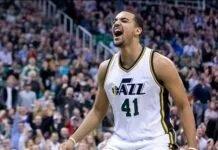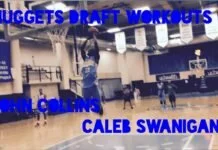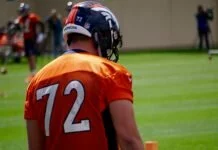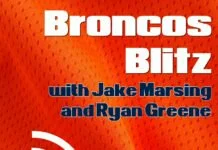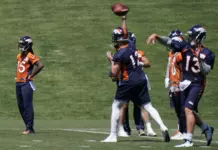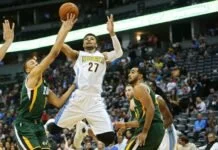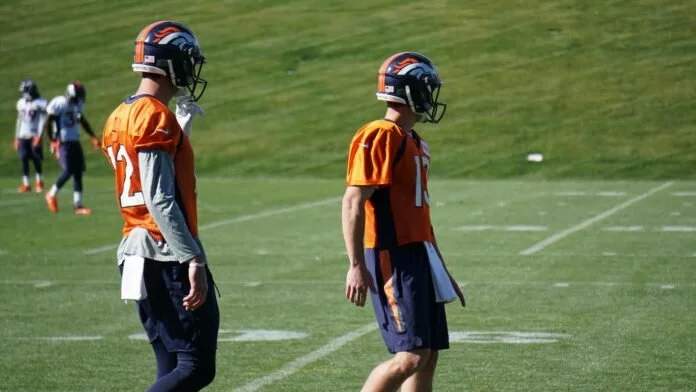With neither Paxton Lynch nor Trevor Siemian shooting out of the gate last year, fans are forced to wonder if they have what it takes to be the next great Broncos quarterback.
Much has been written about what skills Lynch and Siemian do or don’t have. What is often overlooked, is what circumstances surround the early years of a quarterback, and the affect they have. Is a strong offensive line actually needed? Do stout defenses actually help quarterbacks succeed?
In part one of this three-part series, the low odds of success were laid out for quarterbacks taken later in the draft (outside the top 10). In part two, the paths to get on the field was examined for the few successful, yet later drafted quarterbacks. In this concluding piece, the circumstances surrounding those quarterbacks are examined in more detail.
To recap, the top ten quarterbacks drafted outside the top ten have been the focus of this series. They are Tom Brady, Drew Brees, Aaron Rodgers, Ben Roethlisberger, Jay Cutler, Joe Flacco, Russel Wilson, Matt Schaub, Andy Dalton and Tony Romo. They are collectively referred to as the group of ten.
DEFENSIVE
Among the group of ten quarterbacks, there was again a wide range among the defenses that the quarterback was paired with. There did seem to be a very clear trend: the better the defense, the better the team’s record during the quarterbacks’ first year starting. Roethlisberger, Wilson and Joe Flacco all enjoyed top 3 defenses while their team made playoff runs. Brady won the Super Bowl his first season and Dalton made the playoffs while their teams’ defenses ranked in the top ten. Romo, Schaub, Cutler, Rodgers, and Brees all saw below average defenses, and consequentially their teams struggled.
The Broncos defense should be a tremendous asset as they look to find their next great signal caller. Of course, their dominant defense may not last forever. The greatest hope is that they find their quarterback before the defense loses its edge.
RUSHING ATTACK
With the group of ten quarterbacks, there was again a divide. Wilson, Flacco, and Roethlisberger all benefited from rushing attacks that ranked in the top 5 in rushing yards. Tom Brady, Drew Brees, Jay Cutler, and Tony Romo fell close to the average and Dalton, Schaub, and Rodgers all had below average rushing attacks (although none were lower than 22nd)
It’s no secret that the Broncos rushing attack struggled last year, especially once CJ Anderson went down. The Broncos ranked 27th in rushing yards. Things look even worse when you break it down by games before CJ’s injury (111 yards/game) and after (78 yards/game).
While the Broncos didn’t improve their offensive tackle or running back situation yet, they did add Ronald Leary at guard who could help strengthen the interior to open up more holes next year. A strong running attack appears to be crucial for both the development of young quarterbacks and for their teams’ success.
SACKS
One argument that was repeated by fans last season, was that Dak Prescott benefited greatly from a top notch offensive line, while Siemian was the victim of a horrendous line. The argument implied, or sometimes outright stated, that you could swap Siemian and Prescott and Siemian would put up great numbers behind Dallas’s offensive line, while Prescott would have struggled in Denver.
The question becomes, does a good offensive line help keep sack counts low? Or does a quarterback with a quick release, solid internal clock, and ability to call the correct play/protection keep sack counts low. The answer is probably both.
Regardless, out of the crop of ten quarterbacks, four had significantly below average sack rates, one was average, and the other five had significantly above average sack rates.
One interesting trend that did emerge was that the among this sample set, teams who ran the ball more had higher sack rates. This was surprising, because one would assume that the ability to run and the ability to avoid sacks would both be heavily reliant on a quality offensive line, and would be strongly correlated. It’s unclear if this is an abnormality with this situation or if this trend exists frequently.
Believe it or not, Siemian ranked about average with a 6% sack rate in 2016. Lynch was significantly below average, with a sack rate of 9.8%. The good news for the Broncos is it seems there doesn’t seem to be much of a trend, at least with this data set, between quarterback success and low sack rates.
WONDERLIC
Recently, there has seemed to be an increased focus on Lynch’s poor score on the Wonderlic as well as his intellectual ability. The Wonderlic test is scored from 0-50, and it an intelligence and general aptitude test. Much has been written about the test, with many arguing about its usefulness when evaluating quarterback prospects. Opponents of the test will point to Hall-of-Famers like Terry Bradshaw, Dan Marino, and Brett Favre who all scored in the teens or low 20s.
More recently it seems there are fewer and fewer examples of successful QBs with low Wonderlics. This list of late round QBs is no exception. Every player scored a 25 or higher, with the average score being a 30.
RECEIVER TALENT
One trend that was surprisingly lacking among the group of ten, was the presence of Pro-Bowl wide receivers or Tight Ends. Among the group of ten, only Brady (WR Troy Brown), Roethlisberger (WR Hines Ward), and Dalton (WR A.J. Green, TE Jermaine Gresham) had Pro Bowl wide receivers or tight ends their first season starting. That isn’t to say those quarterbacks didn’t have talented pass catchers.
Lynch and Siemian are already ahead of the curve here. Both Demaryius Thomas and Emmanuel Sanders received Pro Bowl nods last year. The Broncos struggled last year to find a tight end who was a receiving threat. Hopefully A.J. Derby or someone from the draft can emerge and fill that role.
PUTTING IT TOGETHER
While looking at the data, there seemed to be two separate types of quarterbacks on the list. The first (Roethlisberger, Flacco, Dalton, Brady, Wilson) benefited from strong running games, stout defenses which lead their teams to success right out of the gate. The others (Cutler, Rodgers, and Brees) were not blessed with strong defense or running game and thus saw a more pass happy offenses. Their teams were not successful, at least initially. It seems it took more time for quarterbacks in the second group to find their stride, and bring success to their team.
Tony Romo and Matt Schaub seemed to be a bit of tweeners. Romo saw success early despite lacking a sound defense, but he didn’t see the field until his fourth year. Matt Schaub was clearly set up to succeed only when paired with a strong ground game and defense, something he didn’t get his first few years in Houston.
Of course, within these categories, there are always variations. Joe Flacco has provided average quarterback play at best. But throughout his career, he leaned on his defense and rushing attack, and benefited from low fan expectations. Wilson was also blessed with a strong running game and defense, giving him early success. However, Wilson has continued to grow, and has done far more as a quarterback than Flacco ever has.
Aaron Rodgers has never benefited from particularly strong running games or defenses and his first year was no exception. It took a season for him and the Packers to post a winning record.
Jay Cutler never had a defense or a consistent rushing attack in Denver. While the Broncos never achieved much success with Cutler, they did improve in his third season as Cutler developed. When Cutler moved on to Chicago, he was paired with a great defense and rushing attack. Cutler struggled to fill into this new role in 2009, before making a deep playoff run in 2010. 2011 and 2012 seasons were hampered by injuries, and from 2012 onward the Bears defense has reverted to nearly last in the league.
It’s also crucial to note that only quarterbacks drafted outside the top 10 who have had successful careers are being examined. There are, no doubt, plenty of quarterbacks who were put on great teams, with great defenses and rushing attacks, but who still flamed out. Mark Sanchez of the Jets, Drew Staton of the Cardinals, Kyle Boller of the Ravens, Christian Ponder of the Vikings, and Rex Grossman of the Bears are just a few of the many examples.
WHAT IT MEANS FOR THE BRONCOS
If either quarterback on the roster is a success, it seems much more likely that they will follow the path of the Joe Flacco or Ben Roethlisbergers rather than the Aaron Rodgers or Jay Cutlers. The team is, in some ways, set up for this having a very strong defense. The lack of a running game is concerning. The glimmer of hope is that the offensive line may be set up to show greater improvement in run blocking rather than pass blocking. Run blocking has historically has been more important for success for later drafted quarterbacks. Additionally, hopefully Anderson can stay healthy for the entire year and Devonte Booker can improve upon his rookie season.
As mentioned in Part I, it’s important to remember than any quarterback who isn’t highly sought after coming out of college faces an uphill battle and long odds. It’s clear that the Broncos quarterbacks have some pieces needed for success, while there is uncertainty surrounding other pieces.



